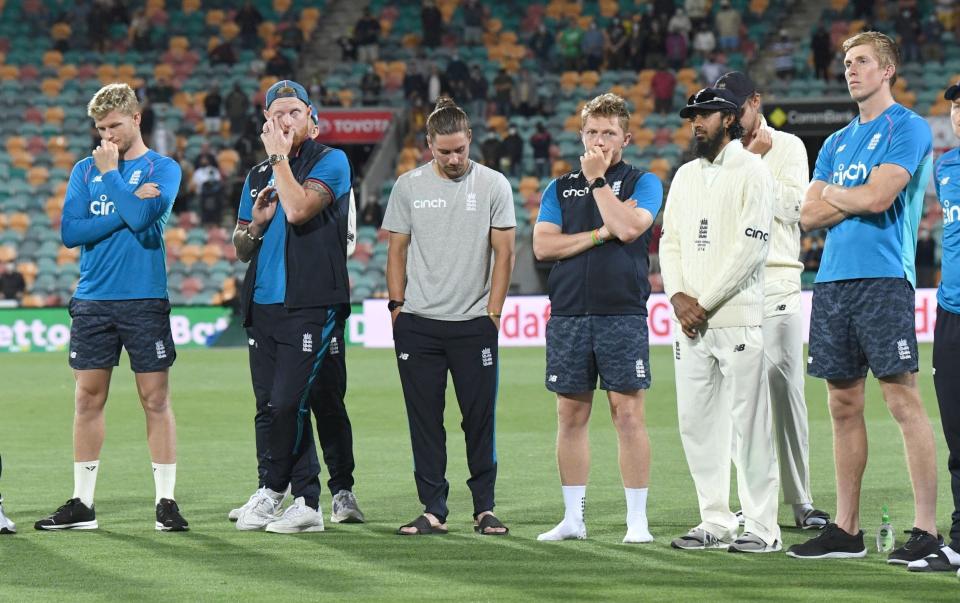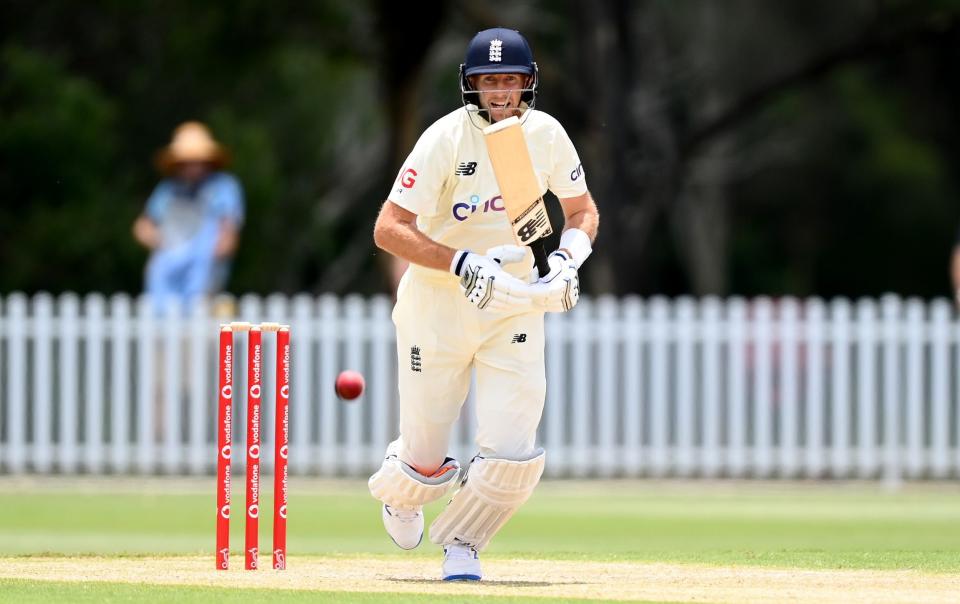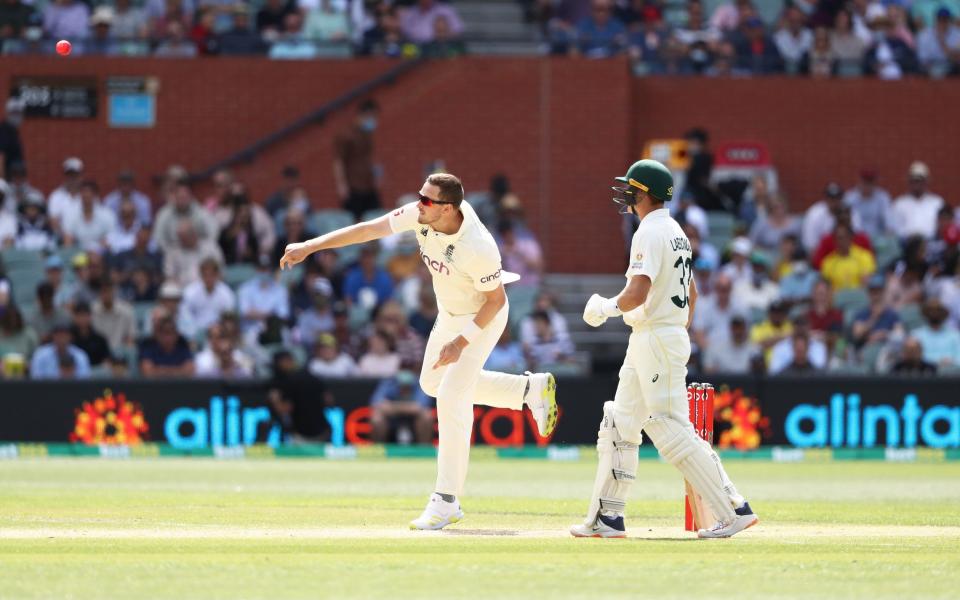'Fat shaming', drinking culture and not enough talking: the inside story of England's Ashes disaster

England saved their worst for last as they signed off a calamitous Ashes series in Hobart with their most shambolic collapse of a tour littered with contenders.
They lost all 10 wickets for just 56 runs, queueing up to throw away their wickets in a blitz of hapless dismissals in the space of 22.4 overs. It was an embarrassment that will take some getting over and only increase the call for change in a set-up that has not only forgotten how to win but how to compete.
The nailbiting draw in Sydney means Joe Root's side will not go down in the history books with their whitewashed predecessors from 2006/07 and 2013/14, but few would disagree that this has been a less competitive and less accomplished campaign.
How did it come to this?
Preparation
This was the theory: “We want to travel to Australia fitter, faster, leaner, more ready than ever before," said England head coach Chris Silverwood last year.
This, according to one player, was the reality: “Honestly, everyone has got a story about how shambolic it has been.”
From the moment England's players set off for Australia on Nov 4, everything that could go wrong, did go wrong, although in fact the disaster was set in motion well before even then.
Preparation had already been hampered by the group being split in two between those who went to the UAE for the World Cup and the others who flew direct to Australia. They were separated for two weeks while those from the UAE did their quarantine on the Gold Coast, further hampering communication and planning.
The bubble made everything harder when it came to organising nets and matches for those in Queensland. England’s only warm-up game descended into farce at the Ian Healy Oval, a nice club ground but lacking facilities for international sport. The scoreboard failed, the team analyst could only film for one day before giving up due to a lack of technical support and what was supposed to be a first-class fixture descended into middle practice with players batting three or even four times.

No sensible judgements could be drawn, but on the back of this game England picked Ollie Pope ahead of Jonny Bairstow for the first Test. Rain did not help, of course, but having agreed such a tight schedule, England were always hostages to fortune. Rain forced bowlers to try and attune to Australia indoors, instead of on the rock-hard pitches, and batsmen had to become accustomed to the bounce against bowling machines, and coaches with dog throwers. Why England, so badly undercooked, then batted first in Brisbane is a question that will haunt Root and Silverwood.
Even once the series had started, the spectre of Covid hung over the tour. Players have become wearily used to PCR testing but even their patience snapped in Sydney when they were forced to undergo a much more invasive procedure because the testing clinics were unable to turn around normal PCR tests in time.
This procedure involved a swab going up the nose and down the back of the throat in one go and is not very pleasant. Some players refused to do it, others did it and then made a stand saying they would not let their partners and young children go through the same procedure. It led to the biggest row between players and management of the whole tour and was only resolved by the resumption of normal PCR testing for those who refused.
Selection
When the issue of England's awful selections for the first two Tests was put to Silverwood, he replied that the series was "a marathon, not a sprint".
He was wrong. An Ashes tour is like an 800m race: you sprint and hope you can hang on long enough. Fall behind in Australia and it is all over. England mistakenly thought they could copy India's success in 2021 and make it a squad game, but they lacked the depth and leadership to make that happen.
England left out James Anderson and Stuart Broad in Brisbane, with concerns over their fitness. While Anderson was understandable, Broad - even if he had only just returned from an ankle injury - was ready to play on a green pitch that was more befitting his home ground of Trent Bridge than the Gabba.
Unleashing him against David Warner, his 'bunny' from 2019, seemed a no-brainer and yet England picked Jack Leach ahead of him. Only Mark Wood, briefly, went round the wicket to Warner on the first morning. As soon as Broad did so in Melbourne and Sydney - when it was far too late - Warner's threat declined and he ended with a pair.
Had England bowled first and thrown their own bowlers at an equally undercooked Australia they may have gained an early foothold. Instead Root - who regularly pokes fun at Nasser Hussain for bowling first in Brisbane in 2002 - wanted to be bold and send a message by batting first. And so batsmen who had mainly netted indoors were bowled out for 147. There was no way back.
The bad calls did not end there - chief among them being England's handling of Wood. The Durham bowler became the tourists' prized asset, their only genuine pace option, and yet he ended up bowling more overs when the series was dead than when it was alive. What a waste.
England had stacked their chips on the pink-ball Test in Adelaide because Anderson had taken 5-43 there four years ago. But having relentlessly extolled the virtues of pace for the last four years, they picked the same three seamers - Broad, Anderson and Chris Woakes - who had lost at the same venue in 2017 by 120 runs. They were worse this time.
Leach was not picked because England had been spooked by how he was mauled in Brisbane. They ended up using two part-time spinners and Ollie Robinson bowling off-spin and had to watch as Nathan Lyon took five wickets for Australia. Even the groundsman tried to warn them, saying 48 hours before the game: "History says that the pitch will spin." England did not listen.

Even selection away from the Test team was in chaos. On the first day of the Gabba Test, England Lions were due to play Australia A. England could have used it to give time in the middle to Jonny Bairstow, Dan Lawrence and Zak Crawley. Instead Mo Bobat, the performance director who is in charge of the Lions, picked the team 48 hours before the game. England only realised their error when they saw that Australia A included Test squad players Usman Khawaja, Micheal Neser and Scott Boland. All would later play in the series and make an impression, while England were left to pick from players who had played no red-ball cricket.
Selection was made mainly by the coach and captain but also chief scout, James Taylor, back home in England, with Bobat contributing. Players were frustrated that Taylor, who was not even in Australia, could have so much influence from thousands of miles away.
Culture
As Silverwood reflected on the tour he wondered if he had been too soft on the players. Certainly the cosiness of the set-up has been a major talking point.
One player refused to take part in the skin-fold test - a gauge of body fat - and, when pressed, accused England of trying to fat shame him. The test was never carried out.
Fitness levels clearly dipped for some players, who started the tour in good shape but appeared to let that side drift as the tour went on. Robinson's conditioning was an issue from the first Test, when he spent time off the field, but became a recurring theme in every game.
When England had the chance for a day off in Hobart, Robinson went and played golf even though he was troubled by a shoulder problem that threatened his chances of playing, with Craig Overton preparing to play in his place. Robinson declared himself fit on the morning of the match but then went down with a back spasm. England needed to be tougher and the medics overrule him but Silverwood and Root needed a win and Robinson is a good bowler.
There were also concerns over a drinking culture within the whole touring party and whether restrictions were loosened too much in Brisbane in the weeks leading up to the series and before the Covid bubble was tightened when families arrived.
Seeking solace in the glass is not unusual on Ashes tours and even more so in bubbles, which have a two-fold effect. The players have drinks laid on in the hotels which are at least away from camera phones and the public, but on the rare days they are allowed out they are more likely to go wild. It is certain that the midnight curfew introduced by Andrew Strauss will return when Covid bubbles go, the players failing to do enough to convince the management they can be fully trusted again.
Silverwood's management style was also an issue. He finds press conferences and broadcast interviews uncomfortable and struggles to express himself, which begs the question of how he handles team meetings and speaks to players.
Some senior players felt left out of discussions over tactics and another was angered to learn he had been dropped after reading it in the press. Another felt he had not been given enough time to prepare for a Test, learning only 48 hours before that he would be playing.
There are mitigating circumstances: insiders felt it was because Silverwood had too much on his plate and struggled to delegate to his staff, some of whom also found it hard to step up to the demands of an Ashes tour, a situation not helped by him contracting Covid.
There is also the point that minimal communication can be interpreted as strong leadership when the team are winning, but with this particular group - few of whom are natural leaders - more interaction was needed.
Tactics and performance
Dropping 17 catches and taking three wickets with no-balls added up to an entire Test match of missed chances and those mistakes come down to discipline and hard work. England bowlers, particularly Robinson, constantly overstep when bowling in the nets and it cost him the wicket of Marnus Labuschagne at the Adelaide Oval.
The decision to use Stokes as an enforcer was a gamble on hard Australian pitches in sweltering heat and with his lack of cricket. It is a punishing routine for a bowler to go through and Stokes snapped in Sydney, suffering a serious side strain that affected him for the rest of the match and the Hobart Test, too.
The tactics for Leach also caused bemusement among the squad. Before the Brisbane Test it was agreed England would be defensive when Leach came on for the first time, knowing Australia would be scenting blood. Players were incredulous when Root brought the field in and attacked, with Leach being taken apart by Australia's top order. It took him weeks to get over and affected selection for Adelaide.

Yet there were also issues around players not taking enough individual responsibility. Before Brisbane, Burns was asked if he had thought about facing the first ball of the series. “Nah, not really", was his reply.
That lack of forethought showed as he was bowled around his legs by Mitchell Starc. Ultimately, Burns lost his place, not just because of his form, but also his failure to speak more regularly in meetings and bring his experience to bear.
And when communication was clear, it still backfired. After the Adelaide Test there was a lengthy team meeting in which Silverwood made the batsmen watch footage of their dismissals, but the exchanges became heated as batsmen and bowlers lined up against each other.
In the same meeting, Jos Buttler told players they had to be patient at the crease, but he was out in the next Test hitting to deep-square leg on the stroke of tea. It summed up his tour.
"One team meeting was never going to change anything," said one player present.

 Yahoo Sport
Yahoo Sport 





































